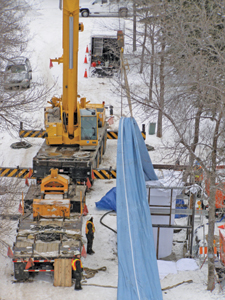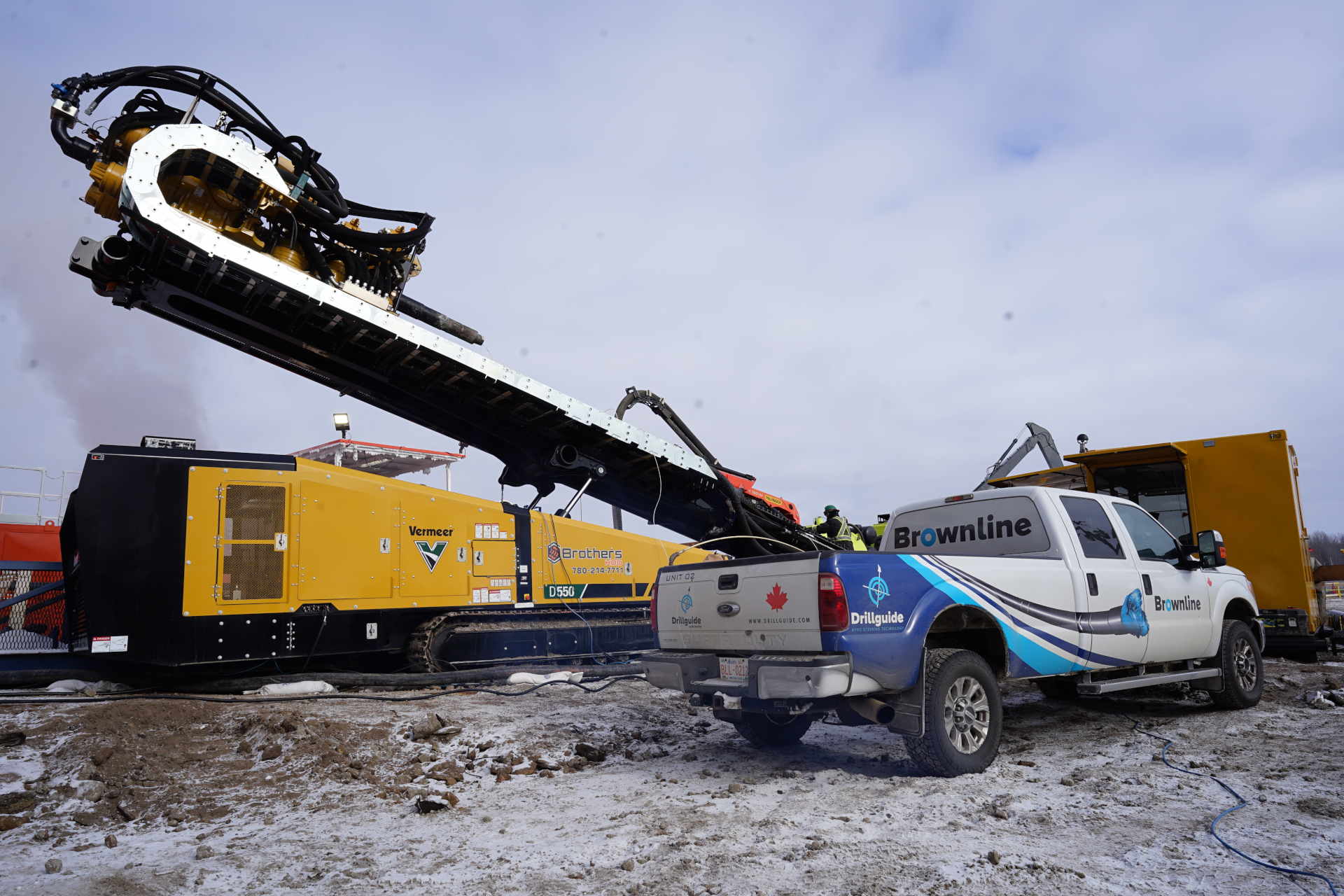Using CIPP in Canada to Rehab Storm Sewers
November 1, 2008
 In April 2007, a significant sinkhole developed a short distance upstream of one of the City of St. Albert’s primary storm outfalls into the Sturgeon River, within relative proximity to multiple private residences.
In April 2007, a significant sinkhole developed a short distance upstream of one of the City of St. Albert’s primary storm outfalls into the Sturgeon River, within relative proximity to multiple private residences. A subsequent investigation revealed that the sinkhole developed as a result of considerable exfiltration through deteriorated and/or separated pipe joints in the storm trunk sewer. This caused gradual ground loss in the area around the pipe, which eventually propagated into development of the sinkhole.
This article discusses the events leading up to the development of the sinkhole, the challenges associated with repairing the pipe and the resulting cured-in-place pipe (CIPP) rehabilitation of the 1,500-mm (60-in.) and 1,650-mm (66-in.) diameter storm trunk in this area.
A Bit of History
Installed in the early 1970s, the Butterfield Storm Sewer includes 265 m (874.5 ft) of 1,650-mm diameter and 55 m (181.5 ft) of 1,500-mm diameter pipe running primarily through utility rights of ways along the rear of residential lots on Butterfield Crescent in the Braeside neighborhood of St. Albert, Alberta, Canada.
The Butterfield Storm Sewer forms the downstream portion of one of the City’s primary storm trunk sewer systems, providing stormwater conveyance capacity for an area of approximately 530 ha.
Closed-circuit television (CCTV) inspection of the Butterfield Storm Sewer in 2003 revealed some joint deterioration along the downstream portion of the trunk sewer within 50 m of the storm outfall. As a result of the CCTV inspection, the trunk sewer was identified for repair under the City’s annual Sewer Rehabilitation Program.
Due to funding limitations, rehabilitation of the Butterfield Storm Sewer was postponed so that priority repairs to the wastewater collection system could be completed. The City subsequently scheduled regular monitoring of the pipe for structural failure.
Sinkhole and Pipe Failure
In April 2007, a sinkhole developed approximately 15 m (49.5 ft) upstream of the storm outfall. Subsequent inspection of the pipe noted a number of structural deficiencies, including extensive deterioration of the invert of one section of pipe and massive joint separation and deterioration through an appreciable length of the downstream reach of the trunk sewer.
In early May 2007, the City retained Stantec Consulting Ltd. to study the situation and determine the most suitable repair method to reinstate long-term performance of the sewer.
Early investigation revealed that the sinkhole developed due to exfiltration of the base flow through the defective joints and deteriorated pipe section. What had started as minor exfiltration through a few deteriorated joints had, over time, accelerated deterioration of the pipe, eventually resulting in enough ground loss around the pipe to cause the formation of a sinkhole.
The City completed an emergency repair of the pipe section with the deteriorated invert in June 2007. A steel plate was used to bridge the eroded section of the pipe invert and anchored into the pipe. The sinkhole was excavated to determine its extent and low-strength grout was injected through the pipe joints to fill the void around the pipe.
Sewer Rehabilitation Planning
CCTV inspection of the downstream reach of the storm trunk sewer was completed in July 2007 to determine the extent of structural deficiencies in the area. The inspection revealed joint deficiencies extending through the storm trunk sewer to approximately 320 m (1,056 ft) upstream of the outfall.
Due to the alignment of the storm trunk sewer along Butterfield Crescent, pipe failure or further propagation of the sinkhole would have the potential to significantly impact private residences in the area. At one location near the outfall, the edge of the Butterfield Storm Sewer is only 2.4 m (8 ft) from the side of a house.
To mitigate the risk to private property, the City directed Stantec to review alternatives for long-term rehabilitation of the sewer pipe for construction in late 2007. Due to the proximity of adjacent houses to the utility right of way, surface access through this area would be extremely difficult and expensive, very disruptive to the residents and pose significant safety issues. Therefore, various trenchless rehabilitation methods were reviewed.
In consideration of the pipe diameter and length to be rehabilitated, the most suitable options for rehabilitation were determined as follows:
- CIPP
- Spiral-wound pipe renewal (SPR)
- Sliplining
- Segmental structural panels
- Based on cost, contractor availability and schedule, the City elected to pursue CIPP lining for rehabilitation of the trunk sewer.
- Rehabilitation
- Insituform Technologies Ltd. was contracted by the City in October 2007 to complete CIPP lining of the Butterfield Storm Sewer.
Upon examination of the site and based on transportation requirements for the tubes, it was determined that the liners should be installed in three separate inversions using a water inversion/hot water cure method. Air Invert Steam Cure (AISC) was explored as a possibility, but since the job was scheduled to occur in November/December 2007, it was determined that the safest option was to use a water cure.
The first inversion would be approximately 130 m (429 ft) in length and would consist of 55 m (181.5 ft) of 1,500-mm (60-in.) diameter and 75 m (247.5 ft) of 1,650-mm (66-in.) diameter liner. The second and third inversions would each be 1,650 mm (66-in.) in diameter and approximately 100 m (330 ft) in length. A new manhole would be provided in a public utility corridor crossing the utility right of way.
The existing manholes along the storm sewer consisted of standard 1,200-mm (48-in.) diameter barrels. Due to the size of the pipe to be lined, the liners were larger than the access area provided by the manholes. To allow insertion of the liners, a new manhole in the public utility corridor would be constructed of 1,800-mm (72-in.) diameter barrels, while the existing manholes required for access would be enlarged to the same diameter.
Each tube was a standard CIPP un-reinforced liner, produced and manufactured by Insituform in Batesville, Miss. The tubes were shipped to Edmonton in late October and stored until required. The design requirements dictated the use of Insituform 102TA resin. This resin was procured from Alpha-Owens Corning in Valparaiso, Ind., and shipped to Edmonton, where it was to be mixed with a catalyst. This job required approximately 107,800 lbs of resin, all of which was delivered to Edmonton in 499.4-lb barrels.
Field work commenced in late October with Insituform’s subcontractor, CKB Construction Ltd. of Edmonton, constructing the new manhole and enlarging the existing manholes required for access.
Installation of the liner took place over a 10-day period in December 2007. Each liner was wet-out with resin using serial vacuum impregnation at Insituform’s shop in Edmonton. The liners were transported to the site on flat deck trailers instead of standard refrigerated trucks due to their size. The ambient temperatures over the period were below freezing, therefore the risk of a premature exothermic reaction was limited.
Installation of the liners using the water inversion process was slow due to the length of the liners and the volume of water required. Inversion of each liner took approximately six to eight hours, after which time the curing process could begin.
To obtain cure temperature as quickly as possible, Insituform used two hot water boilers. The boilers were used to heat the water inside each liner until the liner “kicked,” indicating the occurrence of an exothermic reaction. When this occurred, one of the boilers was shut down and a single boiler was used to hold temperature during the curing of the liner. Cure times varied for each liner, as local ground conditions at each segment provided different challenges.
The temperature of the interface between the liner and the host pipe was monitored every 15 minutes at both the upstream and downstream ends of the liner to ensure that the required cure temperatures were reached at the coldest point in the system. Typically the liner was held at its required cure temperature for 12 hours to ensure that the liner was cured completely.
Once the liner was cured, cool-down of the liners could begin. In each case, small holes were drilled in the liner at the end of the inversion and cold hydrant water was pumped into the liner at the top end of the inversion to bring the system temperature down to near ambient temperatures.
All cure water that was released from the tubes was captured in the outfall structure and pumped into the wastewater collection system for treatment. With cool-down complete, the liner ends could be cut out and removed. The removal of the liner ends and final cutting of the interface of the manhole and the liner took place once all the liners were installed.
Ongoing Asset Management
The City manages an inventory of more than 200 km (124 miles) of storm sewer with a replacement value of approximately $500 million. Current capital reinvestment and operational budgets are being increased to ensure sustainable asset management practices are continued in the future for storm sewers and other asset categories. The City recently developed its own CCTV inspection services crew to ensure sewer pipes throughout St. Albert are assessed on a minimum 10-year cycle to identify potential pipe failures similar to this one in the future.
The City takes pride in being a leader in municipal asset management for mid-size cities in western Canada. With direction from the second phase of the St. Albert’s Infrastructure Review, asset specific inventory and condition assessments have been completed on the infrastructure “hot spots,” which were identified as posing the most risk to the City of St. Albert.
Conclusion
This project represents an excellent example of the advantage of trenchless technology over conventional construction methods through fully developed urban areas. The project was completed on a tight schedule, with significantly less surface disruption and public impact and at less expense than would have been possible with conventional open-cut construction methods given the site constraints.
The Butterfield Storm Sewer CIPP Rehabilitation project is one of the largest CIPP lining projects completed in western Canada and includes arguably the largest diameter CIPP liner installed in a municipal storm sewer in western Canada.
Adam Crutchfield is with Insituform Technologies Ltd., Phil Dixon is with the City of St. Albert, Canada, and Dave Krywiak and Dan Willems are with Stantec Consulting Ltd.




